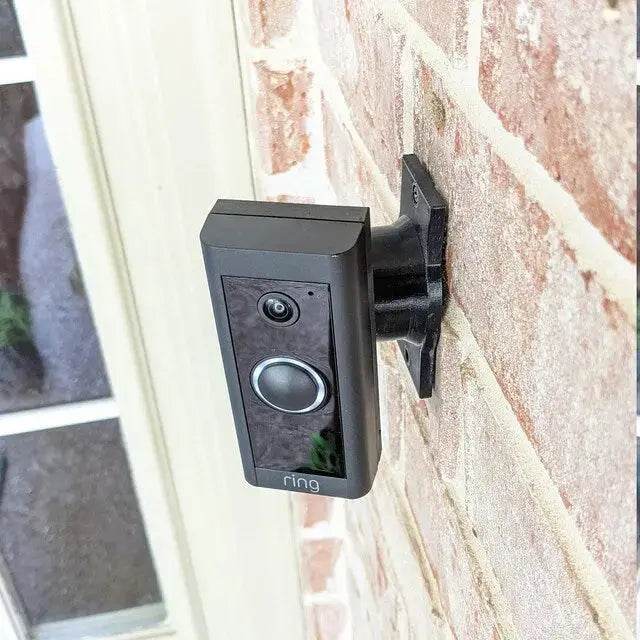Frequently Asked Questions
1. What tools do I need to mount a doorbell on a brick or concrete wall?
2. How high should I mount my doorbell?
3. What type of drill bit should I use for drilling into brick or concrete?
4. How do I ensure the doorbell is securely mounted?
5. What should I consider when choosing a doorbell?
Master the Art of How to Mount Doorbell on Brick or Concrete
Are you excited to enhance your home’s security and convenience with a doorbell? Mounting a doorbell onto a brick or concrete wall may seem daunting. However, with the right tools and techniques, you can easily achieve a professional-looking installation. In this guide, we’ll walk you through the process, providing expert tips to help you choose the best adjustable doorbell mount, and ensure your new doorbell is securely fastened. YOu will find out how to Master the Art of How to Mount Doorbell on Brick or Concrete
Understanding the Basics of Doorbell Mounting
Before delving into the specifics of mounting a doorbell on brick or concrete, it's essential to understand why proper installation is critical. An improper installation could lead to repeated damage to your doorbell or the wall and may affect the performance of your doorbell. Here’s what you need to know:
- Wall Material: Brick and concrete require specific installation techniques due to their hardness.
- Doorbell Type: Different doorbells may have varying installation requirements.
- Weather Resistance: Ensure the doorbell can withstand the outdoor elements.
Gathering the Right Tools and Materials
Before you start mounting your doorbell, it’s vital to gather all necessary tools and materials. Here’s a list to get you started:
- Drill with masonry bits
- Level tool
- Stud finder (if needed)
- Measuring tape
- Pencil for marking
- Place the adjustable doorbell mount (make sure it suits your doorbell model)
- Screws and anchors suitable for brick or concrete
Measuring for the Perfect Placement
To ensure your doorbell is both functional and aesthetically pleasing, proper measuring and placement are crucial. Follow these simple guidelines:
Height Matters
The standard height for doorbells is around 48 inches from the ground. However, consider your home’s design. If you have a unique door style or height, adjust accordingly for optimal access.
Positioning the Doorbell
When choosing where to mount the doorbell, look for a location that is easily visible and accessible to guests. Avoid placing it near obstructions such as plants or furniture. Mark the desired location lightly with a pencil for reference.
Preparing the Wall for Installation
When working with brick or concrete walls, preparation is crucial. Here are steps to properly prepare the wall before installing the adjustable doorbell mount:
Clean the Surface
Remove any dirt or debris from the area where you’ll be drilling. This will ensure a better grip for your screws and help avoid damage to the wall.
Mark Your Drill Points
Using your level tool, ensure that the pencil marks are straight. Mark where the holes will be drilled to fit the adjustable doorbell mount securely.
Drilling into Brick or Concrete
Now that you’ve prepared the wall and marked your points, it’s time to drill. Follow these instructions for a safe and efficient process:
Selecting the Right Drill Bit
For brick or concrete, use a masonry drill bit. Make sure it matches the size of the anchors you plan to use for the doorbell mount.
Drill Guideline
Start drilling at a low speed to create a pilot hole, then increase to a higher speed once the bit bites into the wall. Drill down far enough to accommodate your anchors. Typically, a depth of about 1.5 inches is sufficient.
Installing the Adjustable Doorbell Mount
After drilling, you can now proceed to install the adjustable doorbell mount:
Inserting the Wall Anchors
Carefully tap the wall anchors into the holes you drilled. Ensure they are flush against the wall. These anchors will provide the support needed for securely mounting your doorbell.
Attaching the Adjustable Doorbell Mount
Align the adjustable doorbell mount with your drilled holes, ensuring it is straight. Using screws, secure the mount tightly to the wall until stable. Do not over-tighten, as this may weaken the mount's capability.

Connecting the Doorbell
With the adjustable doorbell mount successfully installed, it’s time to install the doorbell itself. Here’s how to connect your doorbell appropriately:
Wiring Your Doorbell
If your doorbell requires wiring, refer to the manufacturer’s instructions for details. Typically, this involves:
- Disconnecting power at the breaker panel.
- Connecting the wires from your doorbell to the appropriate terminals in the junction box.
- Securing and safely covering any exposed wiring.
Attach the Doorbell
Finally, follow the manufacturer’s instructions for securely attaching the doorbell unit to the adjustable mount. Make sure it clicks or screws into place, depending on your model.
Testing Your Installation
After installation, restore power to the circuit and test your doorbell. Here are some steps to ensure everything functions properly:
Check the Functionality
Press the doorbell button and confirm if it activates the chime or connects to your smart device (if applicable). If it doesn’t work, double-check your wiring connections and the power supply.
Verify Mount Stability
Gently tug on the doorbell to check if it’s securely mounted. If it feels loose, reassess the installation, ensuring the screws and mounts are tight.
Choosing the Best Doorbell for Your Needs
While installation is essential, selecting the right doorbell will guarantee optimal functionality. Consider the following when shopping for a doorbell:
Traditional vs. Smart Doorbells
Decide if you want a traditional wired doorbell or a modern smart doorbell. Smart doorbells allow for integration with home automation systems and provide added security features such as video monitoring.
Compatibility with Your Mount
Ensure that the doorbell you choose is compatible with your adjustable doorbell mount. Check product specifications and dimensions to avoid future inconveniences.
Battery Life and Maintenance
If you opt for a battery-operated doorbell, consider the longevity of the battery and ease of replacement. Smart doorbells should also have options for easy software updates and maintenance.
Enhancing Your Doorbell’s Performance
Once your doorbell is installed, you can take additional steps to enhance its functionality and ensure it meets your needs:
Consider a Chime Installation
If your doorbell doesn’t come with a built-in chime, consider adding one for audible alerts. Some wireless systems allow you to place chimes in multiple locations in your home.
Integrate Your Doorbell with Home Automation
Connecting your doorbell to a smart home system allows you to receive notifications on your smartphone. Explore products compatible with your doorbell for improved efficiency.
Staying Informed and Up-to-Date
Once your doorbell is installed, ensure you stay connected with any advancements in technology or product offerings. Regularly check doorbell-related forums and manufacturer websites to keep your system updated.
Your Path to a Seamless Installation
With the right tools and knowledge, mounting a doorbell on brick or concrete can be a simple DIY project. Follow the outlined steps, from choosing the best adjustable doorbell mount to ensuring proper functionality, and be well on your way to enhancing your home's security. You're now equipped to impress guests and keep your home safe!







